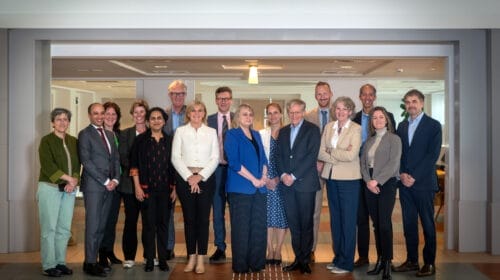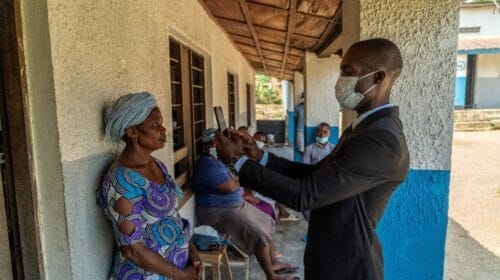The return of Government College Umuahia, by Obi Nwakanma

The Government College Umuahia – one of Nigeria’s most prestigious boarding schools for boys -has an intimidating list of alumni: famous statesmen, leading writers and artists, world class engineers and scientists, Mandarins of the Civil service, top members of the military High Command, entrepreneurs and financiers, bankers – an array of stars, who have over the years, as the school’s song always did compel them, continued to “shine as one.”
It is a remarkable heritage. The “Umuahian” as an alum, or “oldboy” of this school is called, is expected to rise above the lot in any competitive environment. He was prepared for it by the traditions of the school, long established to challenge extremely brilliant and extraordinarily talented kids, often specially selected to attend this very remarkable school, which was the British colonial attempt to model the English boarding school, Eton, in the colonies in a remarkable time. That’s why Umuahia was famously called the “Eton of the East” among educators and students in Nigeria in a particular era.
Its traditions were modelled along the Eton tradition. Its orientation was clearly for the education of gentlemen who were expected to be the leading lights of each of their generations. It was therefore expected of an Umuahian to be a standard bearer, and to raise the torch – that torch that frames the college’s crest – at every moment, and in every place where they plant their feet on the sand.
To be an Umuahian is to be the light that shines in any place of darkness. Umuahians have done this proudly over the years. They have raised their torches, and they have often been the lights of their society. It has often been the joke that the trouble with Nigeria is that because it has been mired in mediocrity, it has failed to use its light.
The only reason why Nigeria is in trouble is that an Umuahian has not led it as president. Nor has any boy from the siter schools at Kings College, Lagos, or the Government Colleges in Ibadan, or Ughelli, and so on. But that is a different issue.
The Government College Umuahia was a child of circumstances. Following the devastations of the First World War fought from 1914-1918, the British suffered a devastating loss of its young men to war, the so-called “lost generation,” most of them educated at Eton, Harrow, Winchester, Marlborough, before Oxford and Cambridge. This loss also meant that the British government had very little human resources to man and administer their so-called “British possessions.” The colonial office had shortages not only in robust youth willing to take up positions in the colonies, there was also shortage of Agricultural products for food and raw materials to feed the people and the postwar industrial plants.
Thus, the British government’s policy under the War time Prime Minister, Lloyd George in 1916, to expand Agricultural production and produce exploitation in the tropical colonies like Nigeria, among others.
This led to the establishment of three Agricultural Research Stations at Moore Plantation in Ibadan, Umudike in Umuahia, and Samaru, Zaria, whose mission was to research and deploy new, modern methods in plant culture and food production. In the upshot, the British colonial administration adopted the Phelps Stokes report on modern education in Africa. Phelps Stokes had commissioned the Ghanaian, Dr. James Emmanuel KwegyirAggrey then fresh out of Columbia University in New York, to travel around Africa and document the prospects for Africa in 1920 and 1921. In 1925, the British Colonial governor of the Gold Coast, Sir Frederick Gordon Guggisberg founded the Achimota College in Ghana (which was to be named the Prince of Wales College) with the Reverend Alec Hall as its first Principal, who had been Principal prior, at Trinity College, Ceylon. Dr. Aggrey was also made First Vice Principal of Achimota.
Among the pioneer masters at the Achimota College was the Reverend Robert Fisher. Educated at Marlborough College and at Pembroke College, Cambridge, where he had studied Mathematics and Philosophy, Robert Fisher had come originally to the Gold Coast as a missionary educator, and had been principal of an Anglican Grammar School in Accra. However, in 1925, he resigned from missionary work and joined the Colonial Education Service as an Education Officer, and from that was posted to be on the pioneer teaching staff at Achimota College.
In Nigeria, meanwhile, S.M. Grier had been deployed from the Department of Native Administration to the Department of Education in the Colonial Administration, and was charged with implementing the Phelps Stokes recommendations. Grier set in motion the process that led to the establishment of the Government Colleges in Umuahia, Ibadan, and Zaria. Notably, these new government schools were established very close to the Government research stations at Umudike, Moore Plantation, and Samaru. Changes in colonial policy also saw the arrival in 1929, of Mr. Eric Hussey as the Director of Education.
Hussey’s policies had great impact in the development of the Government Colleges in Umuahia and Ibadan, from a Teacher Training College in 1929, to a Modern science schools in 1930, and the movement of the Katsina Middle School from Katsina, to become the Government College, Zaria (later called, Barewa College) in 1929. These Government Colleges – Umuahia, Ibadan, Barewa – the first of them Kings College, and Queens College (for girls) had been established in Lagos in 1909 and 1927 respectively – were special schools, different from the Mission run colleges, because they were Government run institutions.
The best of the first class mission schools were in fact a good notch below them, because of their special designations. First, the Government Colleges were more difficult to get into. Second, they were better provisioned with equipment and educational material and resources on tax-payers account.
They had facilities that the mission schools could only dream about, and they were essentially the first places for modern science education in Nigeria. The Government College Umuahia was especially, among these Government Colleges even better endowed in its heyday.
Meanwhile, in 1927, the Reverend Robert William Fisher transferred his services from the Gold Coast to the Education Services of Nigeria, and was appointed Principal of the Government College Umuahia, charged with developing the school. Robert Fisher acquired vast land at Umudike, and built the Government College Umuahia on the road to IkotEkpene from Umuahia, and ten miles from the Umuahia Railway station, at the center of the city. The College grew in leaps and bounds, until it was closed down in 1939/40 to serve as an interment camp for German prisoners of war during WW II. This also effectively marked the first phase of the school.
The final year students of the school were transferred to Kings College, Lagos in 1940, and the rest distributed to various other schools in Eastern Nigeria as a result. Reverend Fisher retired that year and moved back to England where he serve as Vicar of the Anglican Church of St Mary’s in Tottenham.
In 1942 however, a new set of boys were admitted to the Government College, and designated the “Government College Class 1” and placed at Kings College, and house on Customs street in Lagos. Another set of Umuahians were admitted and also housed at Kings College Lagos in January 1943, but in July that year, they were returned to Umuahia to reopen the school. The next class of 1944 soon followed and in 1945, a most dynamic principal, Mr. William Simpson was appointed to the Government College Umuahia. Simpson had been Acting Principal of the Yaba Higher College, and prior, Director of Education in the British Cameroons. His era began what is often called the “Simpson years,” in Umuahia, which saw the admission into the College of Chinua Achebe, C.C. Momah, Christopher Okigbo, V.C. Ike, ElechiAmadi – boys who dominated the tradition of modern letters in Nigeria in that era, and so many more, for which IkpehareAig-Imhokuede once described the Government College Umuahia as “the school for famous men.” That was the generation of boys who in 1948 supplied the highest number of students admitted to the new University College Ibadan, of any other school in Nigeria.
Today, the Government College Umuahia sits on vast grounds – on land larger than the campus of the University of Nigeria at Nsukka. The Government College Umuahia grounds hosts ample facilities for the education of boys, the most privileged of whom have had the opportunity of education of a first class kind under great masters.
Aside from well-built, very modern dormitories, Umuahia had on its campus, the “European Quarters,” which was what the teachers quarters at Umuahia was called because it was a GRA-style Housing area within the school campus, with its leafy green streets, which once had only English masters and just a few Nigerians as senior masters; this of course thankfully changed; there’s the junior staff quarters on the compound which housed the Cooks, stewards, and gardeners; there was the Botanical garden, and the College zoo with an artificial pond that once had a crocodile. There was ample opportunity for sporting life with the nine-hole Golf course; the football field and Cricket pavilion at the Lower Fields ; the Olympic-sized Athletics field at the Upper Fields; seven lawn tennis courts, and basketball courts. Grounds were already broken for an Olympic-sized Swimming Pool under the administration of the principal, I.D. Erekosima, but which could not be completed as a result of the civil war. There is also the vast school orchards, and a large experimental farm, where many an Umuahian had learnt modern farm techniques.
A small cattle ranch had also been planned in 1967 as part of the school’s farm, under the aegis of the Agric Extension Services and Animal Production program of the University of Nigeria, Nsukka, under the Deanship of Professor Bede Okigbo, a distinguished old boy of Umuahia. Again, the civil war did not permit this. It was tradition that the Government College Umuahia hosted every Nigerian head of state and leader of government from the Colonial Governor-General, to the President of the Republic and the Prime Minister TafawaBalewa. And of course governors of the states subsequently that ran Umuahia. The last of these official visits was by Commodore Amadi Guy Ikwechegh, himself an old “Umuahian,” who was Military Governor of the Old Imo state. Things began to go don the hill with the Government College Umuahia, with the Civil war that ended in 1970. But by the end of the 1980s, into the early 1990s, as a result of the neglect of subsequent administrations under military rule, facilities decayed in Umuahia, and its foundation became increasingly shaky and threatened by attrition.
On account of the decay at Umuahia, which had reduced this magnificent school to a terrible shadow of itself, the alumni of the Government College – its oldboys – took the bull literally by the horn. They surveyed the ruins at Umuahia and concluded that a radical surgery was required to save this magnificent but crumbling edifice or let it die. But it would have been a terrible thing to let Umuahia die; a let-down to the past of one of the most distinguished experiments in modern education on the African continent; and so, Umuahians led the charge, and convinced the administration of the Abia state government under Governor Theodore Orji, to cede GCU to a public Trust primarily endowed by the Oldboys of the School. Thus, the Government College Umuahia was ceded to the Fisher Education Development Trust (FEDT) which will henceforth manage the school and midwife its future development.
The point is, the Government College is back!
In the last five years, no new admissions have been made to the college. The last of the state admissions were allowed, and guided to graduate this June, and this September, a new set of boys, who would have taken the Government College Entrance and Selection Examination and properly interviewed, will be admitted to start from Form 1 and begin the new Government College Umuahia. The GCUOBA and Trustees of the Government College Umuahia have worked in the last five years to restore, rehabilitate, rebuild, and in many cases triage old buildings and reconstruct the facilities at Umuahia, including plans to rebuild the old College Art Gallery started by the pioneer Art teacher in Nigeria, K.C. Murray, but which was destroyed and looted during the civil war. A new era has opened at Umudike.
Once more, as happened in 1943, following the devastation of war, a new Umuahia has been reopened, and appointed this time to follow in the footsteps of the great William Simpson is Mr. Clay Springfield, a South-African educator, who will now build on the foundations established by the great Umuahian headmasters – Fisher, Simpson, Cozens, Wareham, Erekosima, Ogujawa, AgwuUche, Nworgu, Onwumere, etc. Now upon his shoulders lie the Herculean task.
But he also has a great distinguished line of examples to follow. The Government College Umuahia is back, thanks to the old boys and other friends of Umuahia, primed again as it admits its new set of boys, to define the 21st century, as it did the 20th century, with its own new generation of “famous men.”
* Dr. Obi Nwakanma, an Umuahian, is Professor of English at the University of Central Florida, Orlando, Florida, USA.
Post Views: 11




